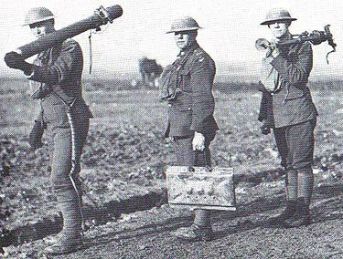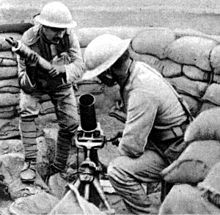Install the app
How to install the app on iOS
Follow along with the video below to see how to install our site as a web app on your home screen.
Note: This feature may not be available in some browsers.
You are using an out of date browser. It may not display this or other websites correctly.
You should upgrade or use an alternative browser.
You should upgrade or use an alternative browser.
Kranaatinheittimistö
- Viestiketjun aloittaja Samses
- Aloitus PVM
Mielenkiintoisista katapulttisuunnitelmista takaisin tylsiin heittimiin. Nyt siirrymme kyllä korkeatasoisempaan keskusteluun kun satelliititkin mainitaan.CIA aseisti mujahedin-taistelijoita 80-luvulla espanjalaisilla 120mm heittimillä. Mukana tuli GPS-tekniikkaa. Lieneekö totta ?
En ollut tällaisesta kuullu mutta kyllä se mahdollista on. GPS-tekniikka oli laajassa käytössä ekassa Gulf-sodassa 1990-91, joten on jonkinlaisia vastaanottimia ollu jo 3 v aikaisemmin 1987. Ekat satelliitit oli silloin ollu jo jonkin vuoden taivaalla. Sen sijaan vanhempi TRANSIT-tekniikka oli ainoastaan merenkulkua varten, sillä tarkkuus oli vain 100 m ja paikantaa voitiin ainoastaan ajoittain. Siihen oli kyllä matkalaukkukokoinen vastaanotin kuivan maan operointiin, jolla mitattiin mm Mount Everestin korkeus (Wikin mukaan, jota ite kyllä epäilen). Mutta tämä järjestelmä ei antanut reaaliaikaista sijaintia, vaan tulokset laskettiin jälkeenpäin tietokoneella.
tulikomento
Supreme Leader
Mielenkiintoisista katapulttisuunnitelmista takaisin tylsiin heittimiin. Nyt siirrymme kyllä korkeatasoisempaan keskusteluun kun satelliititkin mainitaan.
En ollut tällaisesta kuullu mutta kyllä se mahdollista on. GPS-tekniikka oli laajassa käytössä ekassa Gulf-sodassa 1990-91, joten on jonkinlaisia vastaanottimia ollu jo 3 v aikaisemmin 1987. Ekat satelliitit oli silloin ollu jo jonkin vuoden taivaalla. Sen sijaan vanhempi TRANSIT-tekniikka oli ainoastaan merenkulkua varten, sillä tarkkuus oli vain100 m ja paikantaa voitiin ainoastaan ajoittain. Siihen oli kyllä matkalaukkukokoinen vastaanotin kuivan maan operointiin, jolla mitattiin mm Mount Everestin korkeus (Wikin mukaan, jota ite kyllä epäilen). Mutta tämä järjestelmä ei antanut reaaliaikaista sijaintia, vaan tulokset laskettiin jälkeenpöäin tietokoneella.
Tää nyt on ihan mutua. Mutta vuosituhannen vaihteessa muistan nähneeni Milt Beardenin CIA:n historiaa käsitelleessä historiadokkarissa. Kertoi että kehittynyttä aseteknologiaa annettiin aika surutta ääri-islamistien käyttöön. Hällä väliä, kunhan tappoivat venäläisiä.
rty19
Greatest Leader
Tää nyt on ihan mutua. Mutta vuosituhannen vaihteessa muistan nähneeni Milt Beardenin CIA:n historiaa käsitelleessä historiadokkarissa. Kertoi että kehittynyttä aseteknologiaa annettiin aika surutta ääri-islamistien käyttöön. Hällä väliä, kunhan tappoivat venäläisiä.
Ainakin Stinger- IT-ohjusten lahjoittaminen muutti sodankäynnin perusteellisesti.
Mutta tämä järjestelmä ei antanut reaaliaikaista sijaintia, vaan tulokset laskettiin jälkeenpäin tietokoneella.
Ns. korkeamman teknologian käyttäminen silloisella Afganistansotakentällä tarkoitti käsittääkseni AINA SITÄ, että jenkkineuvonantajat olivat mukana. CIA ja armeija kierrätti väkeä tasaisesti niissä tehtävissä. Tämä päti varmasti tässäkin asiassa, josta nyt keskustellaan. Samoin on kerrottu julkisesti, millä tavoin Stinger tuotiin ja koulutettiin alkuasukkaille ja minkä verran se sitoi amerikkalaisia.
Jos Stingereitä olisi kylvetty Afganistaniin miten sattuu, niin mitäpä arvelette, montako lentokonetta tässä maailmassa olisi jo pudotettu niillä terroritarkoituksessa? Ei, kyllä niiden käyttö ja jako olivat erittäin rajoitettuja. Normikuva, jossa muhajeddiini ampuu Stingerillä on vakiokamaa.....mutta valokuvan ulkopuolella sopii olemaan lisähenkilöitä.

Ysärillä kerrottiin, että Stingeriin oli siellä päin maailmaa latauskortti, joita oli operaattorin hallussa useamman sorttisia: osalla korteista pökäle toimi, osalla mykistyi koko vehjes. Ja tämä jenkkioperaattori hallinnoi aina tätä korttipakkaa.
Kyllä katapultista on vielä lähipuolustukseen kun sillä viskaa kasapanoksia lähimaastoon juoksuhaudan suojasta.
Tai optionaalinen rypälepommi, kasa käsikranaatteja joista on otettu sokka pois ja asetettu varovaisesti niin että varmistuskahva ei pääse avautumaan. Käytännössä helpoin tapa toteuttaa tämä lienee käyttää sopivankokoisia lasi purkkeja joihin käkkärit asetetaan.
Ns. korkeamman teknologian käyttäminen silloisella Afganistansotakentällä tarkoitti käsittääkseni AINA SITÄ, että jenkkineuvonantajat olivat mukana. CIA ja armeija kierrätti väkeä tasaisesti niissä tehtävissä. Tämä päti varmasti tässäkin asiassa, josta nyt keskustellaan. Samoin on kerrottu julkisesti, millä tavoin Stinger tuotiin ja koulutettiin alkuasukkaille ja minkä verran se sitoi amerikkalaisia.
Jos Stingereitä olisi kylvetty Afganistaniin miten sattuu, niin mitäpä arvelette, montako lentokonetta tässä maailmassa olisi jo pudotettu niillä terroritarkoituksessa? Ei, kyllä niiden käyttö ja jako olivat erittäin rajoitettuja. Normikuva, jossa muhajeddiini ampuu Stingerillä on vakiokamaa.....mutta valokuvan ulkopuolella sopii olemaan lisähenkilöitä.
Ysärillä kerrottiin, että Stingeriin oli siellä päin maailmaa latauskortti, joita oli operaattorin hallussa useamman sorttisia: osalla korteista pökäle toimi, osalla mykistyi koko vehjes. Ja tämä jenkkioperaattori hallinnoi aina tätä korttipakkaa.
Ei ne kyllä tiennyt missä niitä on ja kuinka monta.
Heti 90 luvun alusta alkaen oli ohjelma jossa niitä ruvettiin ostamaan takaisin.
Lisäksi tuollainen ei toimi pitkään ilman huoltoa. Patterit loppu.
Tässä juttua viimeisestä takaisin osto hankkeesta 2005. Jo silloin pidettiin epävarmana toimiiko enää.
Afghanistan: Kabul Confirms New Effort To Buy Back U.S.-Built Stinger Missiles
https://www.rferl.org/a/1057196.html
Googlettamalla selviää myös että lukuisia epäilyjä stingereistä Afganistanissa, myös pudotuksia. Varma ei tietysti voi olla että onko USAn toimittama stingeri vai esim igla tai jokin muu.
Taliban

Heti 90 luvun alusta alkaen oli ohjelma jossa niitä ruvettiin ostamaan takaisin.
Lisäksi tuollainen ei toimi pitkään ilman huoltoa. Patterit loppu.
Kulla kulla. Mutta alun alkaen Afganistaniin toimitetuissa aseissa oli ihan erikseen taikinoitu vippa, joka tarvitsi aktivoituakseen muutakin kuin paskaisen peukalon pyyhkäisyn.
 Edes amerikkalaiset eivät useimmiten ole niin tahvoja, etteivätkö ymmärtäisi millaisen riskin pitkin maailmaa ajelehtivat olalta laukaistavat muodostaisivat. Varmasti niitä on jäänyt ja joutunut myös ns. vääriin käsiin.
Edes amerikkalaiset eivät useimmiten ole niin tahvoja, etteivätkö ymmärtäisi millaisen riskin pitkin maailmaa ajelehtivat olalta laukaistavat muodostaisivat. Varmasti niitä on jäänyt ja joutunut myös ns. vääriin käsiin. Stingeriä ei ylipäätään ole toimitettu kenellekään ihan noin vaan. Suomenkin muiden muassa piti osoittaa olevansa -kykenevä varastoimaan ja huolehtimaan- ko. aseista. Toimittaja piti vakuuttaa siitä, että toimitettujen aseiden varastointiturvallisuus vastaa stanag äksää ja öötä.
Heti 90 luvun alusta alkaen oli ohjelma jossa niitä ruvettiin ostamaan takaisin.
Lisäksi tuollainen ei toimi pitkään ilman huoltoa. Patterit loppu.
Ns. korkeamman teknologian käyttäminen silloisella Afganistansotakentällä tarkoitti käsittääkseni AINA SITÄ, että jenkkineuvonantajat olivat mukana
Stingerit piti kuljettaa maahan ja varastoida. Silloin niissä saattoi hyvinkin olla veli @baikal in kertoma "taikalaite". Mutta kun ohjuspartiot lähti vuorenrinteille odottamaan saalista, ei jenkeillä ollu laittaa operaattoreita mukaan. Akkujen virran loppumisen vuoden päästä aktivoinnista piti estää jatkokäyttö muualla kuten edellä jo todettiin. Kestihän ne kauemminkin mutta ei maailmalla tapahtunu yhtään vääriin käsiin joutuneiden Stingerien käyttöyritystä. Sitä, onko niitä paljon maailmalta löytynyt eivät jenkit tietenkään kerro.Alun alkaen Afganistaniin toimitetuissa aseissa oli ihan erikseen taikinoitu vippa
Tämä väite taas pitää taysin paikkansa mutta on kuitenkin ihan eri asia. Kaikkiin jenkkien sotatarvikemyynteihin liittyy sama menettely: vaikka meidät todetaan lähtöpäässä sopiviksi vastaanottajiksi, on ylläpidon ja varastoinnin täytettävä jenkkien pykälät. Esimerkkinä vaikka Hornetit v 1995. Lentokenttien paloautojen oli täytettävä vaatimukset, joihin sopi USA:ssa tehty vm 1970 Dodge mutta ei viimeistä huutoa oleva kotimainen Saurus. Brewsterien kanssa oli ehkä helpompaa...Stingeriä ei ylipäätään ole toimitettu kenellekään ihan noin vaan. Suomenkin muiden muassa piti osoittaa olevansa -kykenevä varastoimaan ja huolehtimaan- ko. aseista. Toimittaja piti vakuuttaa siitä, että toimitettujen aseiden varastointiturvallisuus vastaa stanag äksää ja öötä.
D
Deleted member 266
Guest
Stinger-merkkinen kranaatinheitin



KRH:n +:t ja -:t heittimistöä tuntemattomille (tietäjäthän tietää jo):
Kranaatinheittimistön ominaisuuksia
Etuja:
Nämä on jostain isänmaan tarjoamasta KRH-vihkosta.
Kranaatinheittimistön ominaisuuksia
Etuja:
- Sirpalekranaatin suuri tuhoamisvoima suojaamatonta elävää voimaa vastaan ammuksen suuren tulokulman ja sytyttimen suuren herkkyyden takia
- Täysympyrä ampumasektori ja siitä johtuva suuri tulen siirtämisen nopeus
- Kyky nopeaan tulenavaukseen
- Suuri tarkkuus ja mahdollisuus ampua lähelle omia joukkoja maaston korkeuserojen haittaamatta
- Suuri tulinopeus ja mahdollisuus pitkäaikaiseen tulittamiseen suurella tulinopeudella
- Tuliaseman paikantamisen vaikeus suupamauksen perusteella
- Tuliyksikön pieni koko maalina
- Mahdollisuus erikoisammusten käyttöön (savu-, infrapunasavu-, ja valaisuammukset)
- Aseen keveys ja kyky siirtyä tuettavan joukon mukana
- Ammuksen pieni iskuenergia ja siitä johtuva kranaatin pieni tunkeutumiskyky
- Tuliaseman helppo paikantaminen lentoratatutkalla
- Lyhyehkö kantama, joka saattaa rajoittaa tulen keskittämistä
Nämä on jostain isänmaan tarjoamasta KRH-vihkosta.
Viimeksi muokattu:
miheikki
Greatest Leader
Linkkasin tämän jo tuonne tykistöketjuun, mutta kopsataampa tännekkin.

 uklandpower.com
uklandpower.com
Date: January 11, 2018Author: UK Land Power20 Comments
By FinnishInfantryOfficer
This guest article is by a serving Finnish Army Officer, who prefers to remain anonymous. He is an authority on artillery and infantry weapon systems, as well as an active contributor to discussions on key defence topics.
Contents
01 – Introduction
02 – Review of current systems
03 – Comparison with other indirect fire weapons
04 – Conclusion
01 – Introduction
Mortars have been used for centuries, primarily as siege weapons. They differ from conventional artillery by firing projectiles at higher angles, at lower velocities, over shorter distances. Mortars as we know them today first saw light of day during WW1, when the British Army fielded the Stokes 3.2” (81mm) trench mortar. This had a smoothbore tube attached to a circular metal baseplate that was dug-in to the ground to absorb recoil. It had a range of 700 metres and could fire around 25 bombs per minute. Its stand-out feature was that it was truly man-portable.
Above: Stokes 3″ mortar. The first modern mortar from 1915.
After the war and especially during the 1930s, mortars in multiple calibres were honed into the shape and form they exhibit today. Mortar sights from the 1930s remain common and work seamlessly with mortar from 1990s. Advances in metallurgy and manufacturing combined with modern fire control systems that calculate range precisely, have improved effectiveness, reliability and robustness, but the fundamental design and operating concept remains unchanged.
Mortars are usually divided into three categories:
– Light Mortars, ranging from 51 mm to 82 mm,
– Heavy Mortars, usually means 120 mm;
– Super Heavy which refers to 240 mm or larger systems.
During World War 2, 3″ mortars (81 mm) were used widely. Since then, the 120 mm mortar has become a common standard across NATO. Indeed, the only major Western army not to use this calibre of mortar is the British Army.
02 – Review of current systems
The British Army still uses a modern version of the original 3” mortar developed by Stokes during WW1. The L16 81 mm mortar has been used since the mid-1960s. It is fully man-portable with the components divided into loads that can easily be carried dismounted. It has proved to be an extremely reliable system that delivers excellent effect. It has been mounted in the FV432 APC to provide a mobile firepower for infantry battalions.
UK 81 mm mortar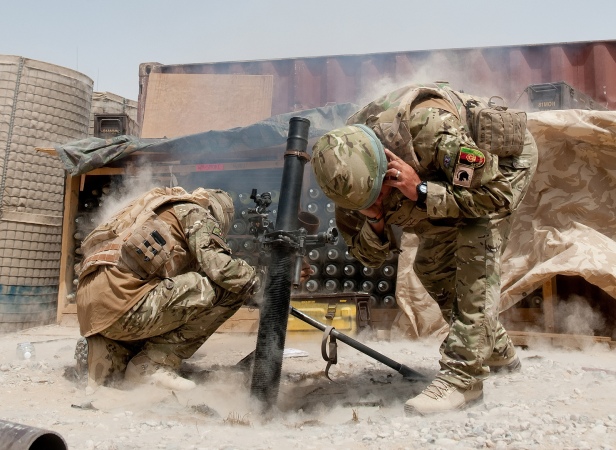
The British Army later adopted a light 2” mortar for use at platoon level. This fired smoke and HE, but was of limited use due to its lack of accuracy. It was later replaced by a 51mm mortar with improved sights and ammunition.
More recently, the 60 mm Hirtenbirger mortar has seen UK service, but since it provides only marginally increased firepower over a 51mm mortar while weighing almost as much as an 81mm mortar, its utility is questionable.
The US, German, French, Italian and many other NATO armies have standardised around a heavy mortar of 120 mm. Primarily used in a towed application, 120 mm mortars are the most ubiquitous of heavy mortar systems in service today, thanks to their ease of use, low cost and low crew requirements. Such weapons have seen worldwide service over the last 50 years. You’ll even find insurgents making such mortars and ammunition in garages in Aleppo.
MO 120 mm towed mortar of the French Army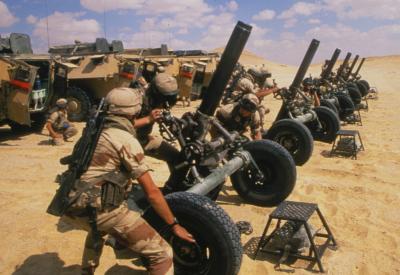
Typical range for a 120 mm towed smoothbore mortar is around 7.8 km using a 2 m barrel. Costs are typically around €370,000 per system. A 120mm mortar with towing kit weighs around 500kg. This is light enough to be hauled across short distances, but too heavy and bulky to be man-portable beyond a few hundred metres. The crew usually consists of 5-7 soldiers. Heavy mortars are usually operated either by infantry or artillery units and deployed according to the standard operating practices of each arm. More often than not, mortars will be owned by infantry units and as such are considered to be a battalion commander’s own “pocket artillery” with approximately 4 to 12 tubes issued per infantry battalion.
Self-propelled mortars existed during WW2, but were generally light weapons. Later, the Soviet 2S9 and a number of other successful post-war medium mortar designs saw service. The US Army mounted a standard 120mm mortar system in its M113 APC, which has now been transferred to its Stryker 8×8 infantry carrier vehicle. The Soviet Army developed the 2S4 Tyulpan 240mm self-propelled super heavy mortar. While offering supreme firepower, it has a slow rate of fire.
The US Army’s m1129 Stryker 120 mm mortar vehicle. This is a highly effective, highly mobile system. Although it lacks the precision and speed of engagement that turret-mounted systems offer, it is less expensive.
In the late 1990s. Finland and Sweden formed a partnership to design and produce a self-propelled mortar. The result was the AMOS 120mm system. This is a breech-loaded, double-barrel design with two 3 metre tubes. It has a 10km range, a Multiple Round Simultaneous Impact (MRSI) capability and a fully-automated fire control system. All of these attributes were unheard of before.
Swedish Army 120 mm AMOS system mounted on a CV90 platform.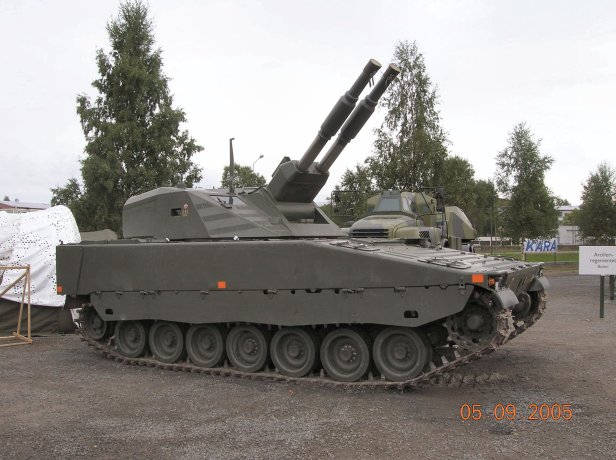
When Sweden dropped out of the programme, Finland was left to finalise development, but fortunately Sweden then adopted it. With the eventual price reaching an eye-watering €5 million per system, the AMOS system begs the question whether the money it cost to develop could have been better spent on some other artillery system? Original plans called for 24 systems in six mortar companies, each with 4x AMOS systems, but the final outcome was 18 in total with three per mortar company. The AMOS design led to its single-barrel brother, NEMO, which builds on the same system advantages making them the world’s most capable self-propelled mortar systems, at least for those with deep enough pockets.
Light artillery: worst enemy or best friend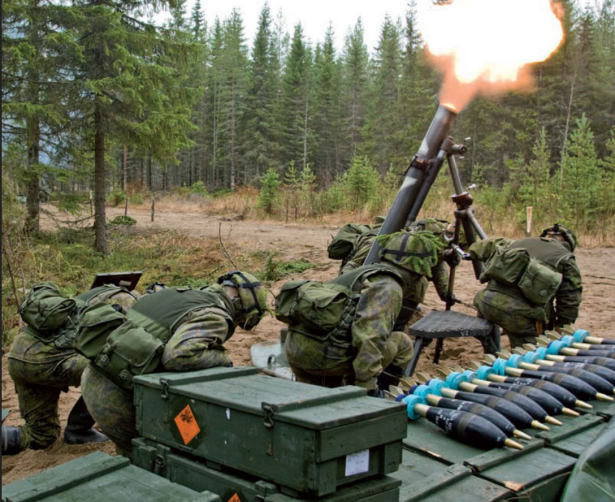
03 – Comparison with other indirect fire weapons
As stated earlier, heavy mortars belong to either infantry or artillery units and this in turn dictates their relationship to other indirect fire weapons. They generally pack a bigger punch over a shorter distance. The obvious pecking order established by most countries that use such weapons is as follows:
– 60mm / 81mm mortars are used at company level
– 120mm mortars are used at battalion level
– 155mm howitzers are used at brigade level.
Declining numbers of soldiers in armies across the globe has seen the need to do more with less and often the solution has been mixed battalion battle groups. The basic premise is to take an infantry battalion and to add whatever supporting units are needed to execute a mission. This has brought tube artillery down to battalion level and, in some cases, stimulated a discussion about what the appropriate level of fire support for battalion-size battle group should be. If we strip the battalion of indirect fire weapons and add weapons that a brigade might have at its disposal, we’re left with following options with their pros and cons:
– 60mm mortar – low logistical footprint and truly man-portable, but short range (~3,800 metres) and limited effect, with minimum penetration of fortifications or buildings
– 81/ 82mm mortars – man-portable, efficient, with the highest ratio of number of kills per tonne of ammunition carried, but short-range (~5,600 metres) and limited effect
– 120mm mortar – very good effect: near misses can destroy lightly armoured vehicles, but only modest range increase over 81mm (~10,000 metres) and less portable
– 105mm howitzer – good range (~17,000 metres) and very good effect on par with 120mm mortar, but requires greater logical support, more crew training and is more difficult to transport
– 155mm howitzer – outstanding range and effect, but requires considerable logistical support including dedicated wheeled vehicles or self-propelled tracked platform.
Picture 1. Despite the apparent simplicity of the 120mm heavy mortar, it still needs a large amount of ancillary equipment, ammunition and has a crew requirement beyond what an RG-32 can carry.
Despite the apparent simplicity of the 120mm heavy mortar, it still needs a large amount of ancillary equipment to support it, plus ammunition and a crew requirement beyond what vehicles like the RG-32 can carry.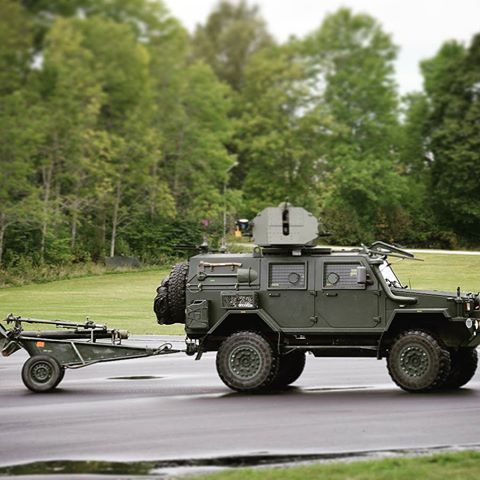
Ultimately, the mission will dictate the ideal combination of weapons needed. It must also be said that a 120mm mortar is not necessarily a substitute for 105mm howitzers. Finland has adopted both a 120mm mortar and a 122mm howitzer in their new battlegroup structure. Together, they are a good example of what massed fires mean. A single battle group has an impressive 42 indirect fire weapons and is capable of firing 468 rounds per minute, if all weapons are aimed at a single target.
Like all towed weapons, heavy mortars suffer from inability to “shoot and scoot.” Of course, trained crews can mount and dismount their mortars quickly enough to qualify as mobile units under optimal conditions, but invariably real combat will introduce other factors that delay the un-packing and re-packing of equipment. Mounted heavy mortars, such as Cardom, have a quasi “shoot and scoot” capability through TALIN or other systems that feed fire control systems the mortars location, deflection and elevation at any given moment. More importantly, they allow the tubes to be dispersed making mortar units less susceptible to counter mortar fire. The downside as always is the price; towed weapon systems cost close to €1 million each, while wheeled platforms cost many millions and defeat any concept of simple and cheap artillery that mortars are supposed to offer.
The UK continues to use the L118 105 mm Light Gun. Compared to towed 120 mm mortar systems, this has double the range: 16-17 km. It has proved to be extremely useful and has seen considerable service across all British Army deployments over the last 30-40 years. it is now starting to show its age. As the UK considers the need to replace or least supplement the L118 105 mm gun, a towed 120 mm mortar could provide a worthwhile increase in capability at an attractive cost.
Finnish Army NEMO – A highly capable 120 mm mortar system. Its ability place five rounds simultaneously on a target is unequalled by any other mortar system.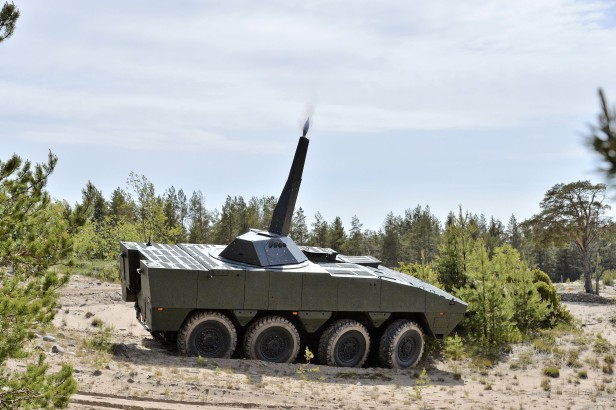
From a technical viewpoint AMOS and NEMO have caught up with 105mm howitzers. While having shorter range they can outgun any 105 with their MRSI and rate of fire. Also, they are inherently capable of “shoot and scoot” fire and movement, which cannot be said of towed artillery. Shorter range means being closer to the enemy, but also allows fire missions to commence with fire for effect, because external influences are fewer and computerised fire control ensures firing values will be accurate, leading to faster engagement times. Hitting a target with the first few rounds is much easier and more certain from 5km than from 13km. Also inherently smaller round dispersion, coupled with faster rates of fire favour the mortar when supporting troops in contact. It should be noted that even battalion battle groups should be able to conduct fire missions that reach an enemy’s rear area, even at ranges of 15 km behind the FEBA. Perhaps an ideal fire support composition for battalion battle group would be fire support battalion comprised of two batteries of 105mm plus a company of 120mm mortars. South Africans have very successfully mixed tube artillery, rocket artillery and heavy mortars into same organisation and there is much to learn from their methods.
120mm mortars do not necessarily replace light towed artillery. This is a Canadian 105mm C3 howitzer.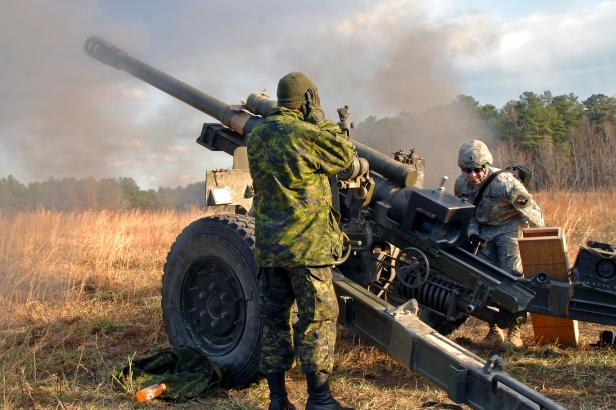
04 – Conclusion
Towed 120mm heavy mortars will remain a primary source of firepower at battalion level for many years to come. Modern self-propelled mortar systems comprise about 1-2% of all heavy mortars used today and using them to replace the remaining 98% would require immense investment. Until then, armies will have to make do with what they have got and manage obsolescence by developing new tactics, adding subtle refinements, such as mortar mounted TALIN and other FCS systems. Irrespectivective of any enhancements, it still takes a painfully long time to dig a pit for a mortar base plate in frozen ground. However, mounted systems come at a cost and depleted forces with fewer numbers means a reduced ability to “make it rain.” A mortar company of 12 mortars can fire 144 rounds per minute, whereas a company of three AMOS vehicles can fire 36 rounds per minute. Choosing between towed and self-propelled systems is more subtle than just comparing a rate of fire of 144 versus 36 rounds per minute. A 120mm mortar system mounted in an 8×8 platform may be an ideal compromise, but may lack precision. Costs are between those of a towed system and NEMO.
Ultimately, this article is nothing more than a rough guide to current mortar systems; and it doesn’t exist to promote AMOS above other mobile systems. The objective is to highlight the trade-offs that need to be made between choosing a larger quantity of older, but capable and lethal legacy systems versus a smaller number of modern, efficient systems in any economically constrained environment. As is often said: quantity has a quality of its own.
Share this:

A Guide to Modern Mortar Systems
By FinnishInfantryOfficer This guest article is by a serving Finnish Army Officer, who prefers to remain anonymous. He is an authority on artillery and infantry weapon systems, as well as an active…
 uklandpower.com
uklandpower.com
D
Deleted member 266
Guest
D
Deleted member 266
Guest
Tuliaseman helppo paikantaminen lentoratatutkalla
Myös kuulo paikannus saattaa toimia.


Mutta tulinopeus on kyllä hyvä.


Kranaatinheitin tiimi vauhdissa taas
Klikkaa itsesi Riemurasian villiin maailmaan!
Oliko tuossa yhdessä videossa joku pyrstövikainen vai miksi -lataaja- hylkäsi yhden ammuttavan?
Eikös siitä olleet lisäpanokset, eli ne siivekkeiden päälle tulevat U:n muotoiset jutut repeilleet.
Virallisesti julki laitetussa videossa meno on hieman sotilaallisempaa. Tosin ei välttämättä kaikki kohdallaan nytkään sillä Karjalan Tykistörykmentissä ei liene koskaan ollu Panssarijääkärikomppaniaa.
Jääkäreitä kyllä löytyy tykistörykmenteistä sillä jo 90-luvulla prikaatien erilliset krh-komppaniat lopetettiin ja siirrettiin tykistöön. Silloin oli ajatus että heitinväki saa ensi alkuun pitää jääkäri-nimitykset ja vihreät laattansa jotta siirtymävaihe olisi kivuttomampi. Mikään ei ole niin pysyvää kun väliaikainen; näin on asia edelleen.
D
Deleted member 266
Guest
Virallisesti julki laitetussa videossa meno on hieman sotilaallisempaa. Tosin ei välttämättä kaikki kohdallaan nytkään sillä Karjalan Tykistörykmentissä ei liene koskaan ollu Panssarijääkärikomppaniaa.
Jääkäreitä kyllä löytyy tykistörykmenteistä sillä jo 90-luvulla prikaatien erilliset krh-komppaniat lopetettiin ja siirrettiin tykistöön. Silloin oli ajatus että heitinväki saa ensi alkuun pitää jääkäri-nimitykset ja vihreät laattansa jotta siirtymävaihe olisi kivuttomampi. Mikään ei ole niin pysyvää kun väliaikainen; näin on asia edelleen.
Eiväthän KRHK:t erillisiä olleet vaan kuuluivat yleensä jääkäripataljooniin eikä kaikkia siirretty tykistöön, kiitos luojan! Vielä hienompaa on se, että KARTR:n 3. tuliasemapatteri uudelleen (jälleen) nimettiin KRHK:ksi.

